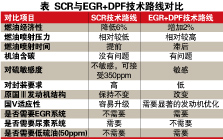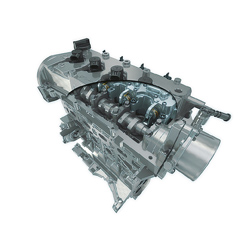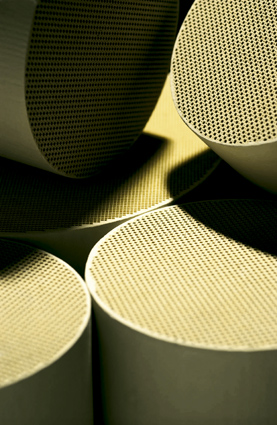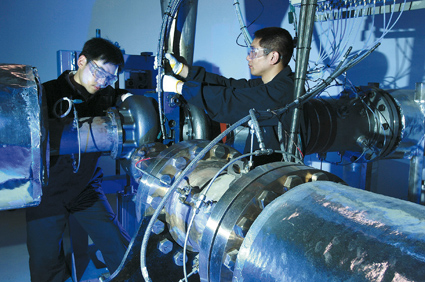According to the implementation plan of the National Automobile Pollutant Emission Standards, China will begin to implement the State IV emission standard for heavy-duty diesel engines in 2010. Based on the experience of European and American auto industry development and China's national conditions, there are mainly two technical routes, namely the SCR (selective catalytic reduction) technology route and the EGR (exhaust gas recirculation) + DPF (particle filter) technology route. Among them, the SCR technology route is mainly to improve the injection timing by improving the injection pressure, and to improve the combustion process, so as to reduce the emission of particulate matter in the engine; and the higher NOX emissions generated by this process are reduced to N2 and O2 using SCR; EGR+DPF The technical route is mainly to reduce NOX emissions below the standard requirements through EGR, and the higher particulate emissions from this process are reduced through DPF to meet the requirements of the standard. The comparison of these two technical routes is shown in the table. In a comprehensive view, the SCR technology route has obvious technical advantages over EGR+DPF in terms of fuel economy, fuel injection pressure, carbon content of engine oil, and sensitivity to sulfur; while EGR+DPF technology requires low packaging and does not require Urea system. Both technical routes have their own characteristics. In accordance with the implementation plan of the National IV Standard, various diesel engine manufacturing enterprises and related industries (tail gas after-treatment systems, fuel injection systems, turbocharger systems, etc.) have carried out a large number of research and development, matching, and production operations. ability. However, whether the technical capabilities and production capabilities of these production companies can meet the requirements of the implementation plan of the National IV Standard in a timely manner are issues that are of great concern. At present, the products of some related industries have already been matched with the technology of the host plant, and the related models have obtained the environmental protection type approval announcement of the Ministry of Environmental Protection. As of October 2009, the number of heavy-duty diesel engines approved by the State IV environmental protection type was about 139. Therefore, the development and matching of relevant models are basically ready, and most manufacturers of heavy-duty diesel engines choose the SCR technology route to implement the National IV standard. Preparation of National IV Standard for Exhaust Aftertreatment Industry Since 2000, China has successively implemented the emission standards of Euro I, Euro II, and Euro III in an equivalent manner. Under the promotion of regulations, the post-processing system industry has grown rapidly. The industry market has expanded rapidly, and a number of domestic companies have also mushroomed. It was born. By the end of 2008, there were nearly 100 companies involved in the automotive exhaust gas after-treatment industry chain (not including catalytic converter production enterprises for accessories), of which more than 20 carrier production companies, 11 or more catalyst coating companies, and thermal insulation liner companies 4 Above, more than 57 catalyst packaging companies. At present, there has been a situation of professional division of labor and mutual support. On the whole, the post-processing system is divided into four parts: carriers, catalysts, insulation pads and catalyst packages. Exhaust gas aftertreatment system carrier sub-industry: The main forms of exhaust gas aftertreatment system carriers include ceramic honeycomb carriers, metal honeycomb carriers, and various forms of particulate traps (DPF) used in diesel engines. Ceramic honeycomb carriers are mainly used in three-way catalytic converters for gasoline engines, diesel oxidation catalytic converters (DOC), and diesel selective catalytic reduction systems (SCR). The metal honeycomb carrier is mainly used for diesel partial-flow particulate filter (POC), selective catalytic reduction device (SCR), and three-way catalytic converter for motorcycles. DPF mainly uses cordierite, silicon carbide or aluminum titanate. As vehicle emission regulations become more stringent, carrier research tends to develop in the direction of thin-walled and high-hole-density carriers. For example, the latest development at present is a thin-walled carrier having a thickness of about 0.05 to 0.075 mm of 600 cpsi to 900 cpsi. Major domestic companies producing ceramic carriers include: Corning (Shanghai) Co., Ltd., NGK (Suzhou) Environmental Ceramics Co., Ltd., Jiangsu Yixing Nonmetal Chemical Machinery Factory, and Jiangsu Gaochun Ceramics Co., Ltd. Metal carriers are mainly provided by the German company Imitac Emission Control Technology Co., Ltd. and Nanjing Ikocat Environmental Protection Technology Co., Ltd. The main companies that manufacture diesel DPF carriers are: Corning (Shanghai) Co., Ltd., NGK (Suzhou) Environmental Ceramics Co., Ltd., Yunnan Feierte Environmental Protection Technology Co., Ltd., and Guizhou Huangdi Vehicle Purifier Co., Ltd. FPT Fiat Power Technology's Original Energy Saving and Emission Reduction Technology - A New Generation of MultiAir® At present, some companies have applied relevant products abroad to implement the Euro IV emission standard in their regions. Their carrier technologies have been very mature and they have mastered the latest thin-walled, high-hole-density carrier production capabilities. In addition, some companies have been able to supply common ceramic honeycomb carriers and particulate traps in batches in terms of technology reserves. The products are technically capable of complying with the requirements of the National IV standard and have corresponding application examples. However, they also have product consistency and other aspects. Some gaps from international mature products. Therefore, the technical preparation of the major carrier manufacturers in China has been very thorough. From the point of view of production preparation, some of the companies currently have localized production of some products in China and have corresponding products used in the National IV models/models. Given that the current market share of China IV diesel engines is relatively small, some manufacturers mainly import corresponding products from abroad to meet domestic demand. However, some manufacturers have already established domestic carrier production lines that meet the national IV standard for heavy-duty diesel engines. Catalyst coating sub-industry: The catalyst is the core component in the post-processing system. The composition, content and coating level of the catalyst are important indicators of the performance of the catalyst and directly affect the purification effect of the exhaust gas. At present, the main components of the catalyst used in automobiles include precious metals, vanadium-molybdenum-tungsten compounds, and iron-copper molecular sieves. Dieselfilter The main companies engaged in catalyst coating in the country are: BASF Catalysts (Shanghai) Co., Ltd., Wuxi Weifu Environmental Protection Catalysts Co., Ltd., Johnson Matthey (Shanghai) Catalyst Co., Ltd., Umicore Automotive Catalyst (Suzhou) Co., Ltd., and Kunming Guilin. Catalyst Co., Ltd. and Fujian Chaori Environmental Protection Technology Development Co., Ltd. etc. In terms of technical reserves, major companies have already been able to coat the National IV diesel engine aftertreatment catalyst. Most of the catalyst manufacturers have set up R&D centers in the country, stating that the company pays great attention to improving R&D capabilities to meet market requirements. In terms of production preparation, most of the products produced by current enterprises are mainly used to satisfy the coating of catalytic converters for gasoline vehicles and DOCs for diesel engines. For the SCR system coating required by China IV vehicles, many companies have already met in technical preparation, but due to the uncertainty of future time and market, they have not yet reached large-scale production, so some companies have adopted foreign catalyst coating. The way to meet the needs of the domestic market, after the increase in the scale of demand, will be transferred to the domestic supply mode. According to another understanding, some companies have introduced large-scale carrier coating equipment and other equipment in accordance with the implementation plan of the State IV emission regulations, and increased investment in 2009. Cushion sub-industry: Exhaust gas aftertreatment system The ceramic expansion seal gasket is one of the important components of automotive catalytic converters. It is located between the carrier and the housing and is mainly used to protect the core of the catalytic converter. The ceramic honeycomb catalyst carrier is not damaged, and it acts as a fixed carrier. And damping effect, and has a good airtight and thermal insulation. Its excellent thermal expansion performance solves the significant difference in thermal expansion between the ceramic carrier and the metal shell, so that the ceramic carrier is protected from uneven road impact and vibration, and the performance of the automotive catalytic converter is ensured. The main companies that manufacture catalytic converter liners in China are: 3M (China) Co., Ltd., Qi Nai United Fiber (Shanghai) Co., Ltd., Linhai Bangdeli Automotive Environmental Technology Co., Ltd. and Shanghai Aesop Thermal Energy Technology Co., Ltd. As the liner is mainly used as a fixed carrier and vibration damping, sealing and heat insulation, the liner in the phase IV stage of the country is basically similar to the requirements of other emission standard stages, and no special upgrade reserves are required for the technology, and the technical capacity and production capacity can be Meet the implementation of the diesel IV standard. Catalytic converter package sub-industry: The exhaust gas after-treatment system catalytic converter package is mainly used to protect the carrier in the catalyst, so that the engine exhaust can fully contact the carrier catalyst. The catalytic converters are roughly classified into three types: clamshell type, bundled type, and plug-in type. The major domestic enterprises engaging in catalytic converter packaging include: Wuxi Weifu Lida Catalysis Purifier Co., Ltd., Emcom Environmental Protection Technology (Shanghai) Co., Ltd., Tenneco Tongtai (Dalian) Exhaust System Co., Ltd. and Shanghai Tenneco Exhaust System Co., Ltd., Cummins Emissions Disposal System (China) Co., Ltd., Suzhou Pageli Emission Reduction System Co., Ltd., and Beijing Luchuang Environmental Protection Equipment Co., Ltd. After years of development, packaging companies have basically formed a complete system of packaging capabilities, product performance is maturing, some companies have small batches of supporting applications in major cities in the country, some companies large-scale carrier packaging capabilities are under construction. In addition, the heavy-duty diesel vehicle post-processing packaging technology is not too large compared to the gasoline engine three-way catalytic packaging technology. Moreover, the main packaging companies have sufficient production preparations and mature technologies. A few companies have stepped up their research and development and follow-up, and will be able to meet the standards implementation requirements in due course. Urea spraying sub-industry: When the heavy-duty diesel engine IV standard adopts the SCR technology route, in addition to the requirement for a complete set of tail gas after-treatment system, a set of urea injection system is also required. This system contains three key components: a urea nozzle, a urea dosing pump, and a urea injection control system. At present, the Urea metering pumps and urea nozzles in the industry are mainly produced by products of Bosch, Wuxi Weifu Lida, Grundfos, Cummins, Tenneco, and Albonair. The control system is mainly controlled by Bosch and various SCR packaging plants. In the urea injection system, it is currently matured and used mainly for imported products. There are also related companies in China that are conducting research and development, such as Wuxi Weifu Lida Catalytic Purifier Co., Ltd., Wuhan Tim Blue Engine Emission Control Technology Co., Ltd., Suzhou Paige Emission Reduction Systems Co., Ltd., and Wuxi Kailong Auto Equipment Manufacturing Co., Ltd. Independently develop urea key components and control systems. Foreign-funded enterprises have already matured their preparation for urea injection technology, and some companies have begun to increase production equipment or increase investment. Independent companies such as Wuxi Weifu Lida Catalyzer Co., Ltd. also bear the national “863†project, and the production capacity will also increase rapidly. Therefore, the key parts and components companies of urea injection system have been actively preparing, and the production capacity will rapidly increase in a short period of time. [next] Preparation of Fuel Injection System for National IV Standard Implementation At present, the main domestic companies that produce fuel injection systems are: Bosch Automotive Diesel Co., Ltd., Delphi (China) Technology R&D Center Co., Ltd., Denso (Changzhou) Fuel Injection System Co., Ltd., Cummins Fuel System (Wuhan) Co., Ltd., Chengdu Witt Electronic Spray Co., Ltd., ASIMCO Industrial Technology Co., Ltd. and Liaoning Xinfeng Jier Fuel Injection Co., Ltd. etc. In terms of supply of major products, among them, Bosch Diesel Automotive Co., Ltd. and Changzhou Denso Co., Ltd. mainly supply high pressure common rail systems; Delphi supplies mainly high pressure common rail systems to light diesel engines, and monomer pumps and pump nozzle systems to medium and heavy diesel engines. ; Chengdu Witt and ASIMCO Nanyue mainly supply electronically controlled single-unit pumps for medium- and heavy-duty diesel engines; Liaoning Xinfeng supplies mainly high-pressure common-rail products for light-duty diesel engines. In terms of research and development capabilities, each major EFI company has set up a corresponding R&D center in China, using domestic R&D centers to introduce products that have been applied abroad, and conduct localized production and technical support. National IV technology and products are basically mature, and the matching models are also approved by the national environmental protection type. In terms of technical reserves, major foreign-funded enterprises have the technical capability of the State IV fuel injection system and can supply the domestic market to meet the needs of the domestic heavy-duty diesel engine market. In terms of production preparation, both foreign-funded enterprises and domestic manufacturers are optimistic about the Chinese market. Foreign-funded enterprises have increased investment and expansion plans in the Chinese market. Domestic manufacturers also set aside sufficient capacity for capacity planning. If the national IV standard will be implemented on time, appropriate measures will be taken and the production capacity will also satisfy the market supply. The New generation of Bosch common rail With its piezo in-line injectors, the 3rd generation common rail of Bosch provides for still more freedom in adaptation of the injection systems to the diesel engine Preparation of Turbocharger System for National IV Standard Implementation In recent years, turbochargers have been widely used in diesel vehicles. China's State III and State IV heavy-duty diesel engines have been equipped with turbochargers. Turbochargers can effectively increase the power of heavy-duty diesel engines, improve economic performance, reduce pollutant emissions, and significantly improve the economics of high-load zone operation. The turbocharger not only increases the power range, but in the low-load region, the turbocharger does not significantly improve the economy, but it also expands the economical operating range of the high-load. This is very significant for heavy-duty diesel cars that are often full-loaded and operating at high speeds. At present, domestic turbocharger companies mainly include Honeywell Turbocharger Systems (Shanghai) Co., Ltd., Wuxi Cummins Turbocharger Technology Co., Ltd., BorgWarner Turbocharger Systems Co., Ltd., and Shanghai Lingzhong Turbocharger Co., Ltd. Company, Hunan Tianyan Machinery Co., Ltd., Shouguang Kangyue Turbocharger Co., Ltd., etc. The Type III and State IV heavy-duty diesel engine turbocharger types are basically the same, but the use of materials and manufacturing process levels need to be improved. The turbocharger system has sufficient capacity to meet the requirements of the State IV heavy-duty diesel engine. The exhaust gas after-treatment system industry, fuel injection system industry, and turbocharger system industry have done a lot of detailed preparation work in response to the implementation of the National IV Standard. From technical preparation, major companies in major systems already have mature technological capabilities. In terms of production preparation, the company has not dared to rush to expand production because of the relatively small scale of production of vehicles complying with the National IV standard. If the relevant department clears the implementation date of the standard, it is believed that the production enterprises of exhaust gas aftertreatment system, fuel injection system and turbocharger system will promptly expand production capacity in all aspects and actively respond to meet market requirements to ensure the smooth implementation of the National IV standard.
Pyrite as Fillers Used in Steelmaking and Core-Spun Yarn
Steel-making/casting core-clad wire (filling material)
Place of Origin: Henan Luoyang, China
Pyrite, Iron pyrites, pyrites lump, Ferro sulphur, Pyrites powder.
Product Description:
Detailed introduction: Is used as the filling material of cored wires and resulfurization additive agent for steel-making and casting. It is used for adding sulfur element in steel smelting to improve the cutting performance, inoculation effect, graphite shape and mechanical properties of gray pig iron.
Quality:
S: 48%min, FE: 42%min, SIO2: 3.0%max, PB: 0.1%max,
ZN: 0.1%max, AS: 0.1%max, . C: 0.3%max, CU: 0.2%max,
H20: 1.0%max, SIZE: 95%min
Granularity: (0-3)mm/(3-8)mm/(3-15)mm/(15-50)mm or other particle size.
Packing: 25KG/500KG/1000KG/BAG or 1000KG/BAG or other packaging.
Note: if there are special requirements, the product can be customized according to clients` requirements.
Steel-making/casting Core-clad Wire --BXX Pyrite, Iron pyrites, pyrites lump, Ferro sulphur, Pyrites powder. LUANCHUAN COUNTY HENGKAI METALLURGICAL MATERIALS SALES CO.,LTD , https://www.pyritechina.com




